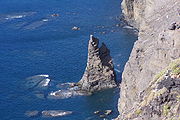
El Dedo de Dios
Encyclopedia


Gran Canaria
Gran Canaria is the second most populous island of the Canary Islands, with a population of 838,397 which constitutes approximately 40% of the population of the archipelago...
, one of the Canary Islands
Canary Islands
The Canary Islands , also known as the Canaries , is a Spanish archipelago located just off the northwest coast of mainland Africa, 100 km west of the border between Morocco and the Western Sahara. The Canaries are a Spanish autonomous community and an outermost region of the European Union...
(Spain
Spain
Spain , officially the Kingdom of Spain languages]] under the European Charter for Regional or Minority Languages. In each of these, Spain's official name is as follows:;;;;;;), is a country and member state of the European Union located in southwestern Europe on the Iberian Peninsula...
). During Tropical Storm Delta
Tropical Storm Delta (2005)
TropicalStorm Delta was a late-forming tropical storm of the 2005 Atlantic hurricane season which struck the Canary Islands as a strong extratropical storm, causing significant damage and then crossed over Morocco before dissipating...
in November 2005, the thin top of the rocky monument was broken off and fell into the sea, destroying its unique characteristic that had the shape of a finger (hence the name "God's finger").
It was one of the many natural monuments of the Canary Islands
Canary Islands
The Canary Islands , also known as the Canaries , is a Spanish archipelago located just off the northwest coast of mainland Africa, 100 km west of the border between Morocco and the Western Sahara. The Canaries are a Spanish autonomous community and an outermost region of the European Union...
located outside the coastal town of Agaete
Agaete
Agaete is a municipality of Las Palmas province, on the Canary Islands, Spain. It is in the northwest of Gran Canaria island, enclosed by the Atlantic Ocean to the west, Gáldar to the northeast, and Artenara to the south...
, at the north of Gran Canaria. The peculiarly shaped rock has been an inspiration to many artists, and it is believed that the author Domingo Doreste was the first to name it God's finger.
The area is considered the oldest on Gran Canaria, and started to form around 14 million years ago. During a time span of 2-300,000 years, the oddly shaped monument was created from the basaltic materials in the area.

